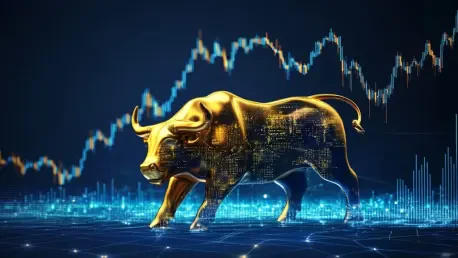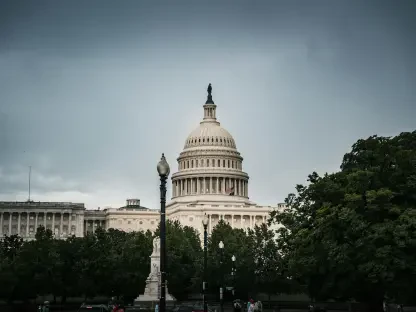The recent fluctuations and trends in the U.S. stock markets have captured the attention of investors and analysts alike. Notable sell-offs followed by attempts at recovery have characterized market behavior in recent trading days. At the core of these movements lie the growing tensions between President Trump and Federal Reserve Chair Jerome Powell. These tensions have profound implications for investor sentiment and overall market performance, heightening uncertainty and fueling volatility. The interplay between executive criticism and monetary policy decisions has become a significant factor influencing trading strategies and market confidence.
Tensions Between Trump and Powell
President Trump’s criticism of Jerome Powell’s handling of interest rates has significantly impacted market volatility. Trump’s remarks have deepened the uncertainty among investors, leading to notable declines in major stock indices, including the Dow Jones Industrial Average, S&P 500, and Nasdaq Composite. By openly labeling Powell as “Mr. Too Late” and “a major loser,” Trump has further aggravated the situation, contributing to a volatile trading environment. This public spat has made investors wary of potential policy shifts and uncertainties surrounding the U.S. economic landscape.
The primary catalyst for this turbulence has been Trump’s insistence that the U.S. economy will continue to struggle unless the Federal Reserve cuts interest rates. This criticism has amplified market instability, causing investors to weigh the implications of possible upheaval at the Federal Reserve. Jerome Powell’s warnings about the negative impacts of Trump’s tariffs also added to the contentious atmosphere. Powell’s stance on maintaining the economic stability of the nation amidst tariff-induced challenges has been met with Trump’s forceful rebuttals, emphasizing the urgency of Powell’s removal. This ongoing discord has eroded confidence in the stability of U.S. economic policy, further contributing to market volatility.
Corporate Earnings and Market Reactions
Several high-profile companies have experienced market impacts due to earnings reports and broader economic conditions. Tesla’s anticipated earnings release has sparked investor concerns regarding sales performance and market demand. Compounded by CEO Elon Musk’s engagements with the White House, these factors have led to a decline in Tesla shares. The company’s performance and Musk’s controversial involvement have intensified market reactions, highlighting the direct influence of corporate earnings on stock movements.
Verizon’s disclosure of a larger-than-expected loss of wireless subscribers, attributed to price hikes and competition, has also negatively affected its stock. This adverse impact is reflected in the significant drop in premarket trading, further influencing overall market conditions. Similarly, Kimberly-Clark reported mixed earnings and revised its annual profit outlook due to potential increases in supply chain costs driven by tariffs. This revelation resulted in a notable decline in its share price, showcasing the interconnectedness of corporate performance and broader economic policies.
In contrast, GE Aerospace provided some positive news by surpassing profit estimates for Q1 and reaffirming its earnings forecast, driven by robust demand for aircraft parts and services. This positive outcome stands in sharp contrast to the broader market sentiment, offering a glimmer of stability amidst the prevailing economic uncertainty.
Global Economic Context and IMF Projections
The International Monetary Fund (IMF) has revised its projections, signaling a “significant slowdown” in global economic growth. This downward revision is primarily attributed to President Trump’s tariffs and the resulting economic uncertainty, which impact both U.S. and global growth projections. The persistent trade conflicts and tariffs are anticipated to have long-term adverse effects on economic growth, consumer spending, and trade dynamics, bolstering a bearish sentiment in the stock markets.
The IMF’s forecast has marked a full percentage point decrease in U.S. growth projections, reflecting the broader implications of policy unpredictability. Globally, growth projections have also seen a significant reduction. Economists have expressed concerns over how these factors will potentially slow down economic activities, disrupt trade patterns, and affect consumer spending habits. This evolving economic backdrop emphasizes the necessity for strategic investment decisions in navigating the tumultuous market landscape shaped by these policies and regulatory disputes.
Analyst Consensus and Market Sentiment
Market analysts have voiced concerns over the compounded effects of regulatory unpredictability and trade policies on stock market stability. The potential ouster of Jerome Powell, speculated by various analysts, adds another layer of uncertainty to the market. Such a drastic move could potentially disrupt bond markets, increase risk premiums, and trigger heightened interest rate volatility. Investors are closely monitoring these developments, reassessing their strategies amidst the fluctuating economic policy landscape.
Economists predict that disruptions stemming from regulatory conflicts could lead to accelerated inflation and possibly steer the U.S. into recession. The amplified uncertainty surrounding U.S. economic policy under President Trump further exacerbates these risks. Market strategists suggest that maintaining vigilance and adopting a cautious approach is essential as the evolving situation continues to unfold. The broader economic policies, intertwined with political dynamics, have created a complex environment that demands careful navigation by investors and analysts alike.
Global Market Reactions
The ramifications of U.S. market volatility have extended to global markets, with Asian and European markets experiencing losses in response to American regulatory and economic policies. Notable declines in regional markets, such as Japan’s Nikkei 225 and Hong Kong’s Hang Seng Index, reflect the global unease over continued U.S. policy shifts and trade conflicts. This reaction underscores the international apprehension regarding U.S. economic stability and its far-reaching implications.
These international market behaviors further influence investor sentiment worldwide. The persistent discourse around tariffs and policy adjustments has exacerbated concerns about the potential ripple effects on global trade and economic stability. Investors in global markets have adopted a more cautious approach, adjusting their portfolios in response to the uncertainties emanating from U.S. economic policy changes.
Safe Haven Investments and Commodities
The increased demand for safe-haven assets, particularly gold, illustrates the broader market response to ongoing trade conflicts and policy tensions. As the dollar weakens, gold prices have reached new highs, reflecting heightened investor risk aversion and economic instability. This shift towards safe-haven investments signifies a broader market trend driven by geopolitical and economic uncertainties, emphasizing investors’ need for security amid volatile market conditions.
The rise in gold prices underscores a growing preference for assets perceived as safer investments during times of uncertainty. Investors have sought refuge in gold and other commodities as a hedge against market volatility and potential currency devaluation. This trend underscores the prevailing caution among market participants, as they navigate the unpredictable economic landscape shaped by regulatory tensions and policy disputes.
Conclusion
Recent fluctuations and trends in the U.S. stock markets have seized the interest of investors and analysts alike. The market has been marked by notable sell-offs, followed by attempts at recovery. Central to these movements are the escalating tensions between President Trump and Federal Reserve Chair Jerome Powell. These growing frictions significantly impact investor sentiment and overall market performance, increasing uncertainty and contributing to heightened volatility.
The back-and-forth between executive branch criticism and decisions related to monetary policy has become a pivotal factor in shaping trading strategies and influencing market confidence. President Trump’s public discontent with the Fed’s policies, especially regarding interest rates, has added an extra layer of complexity. This dynamic raises questions about the future direction of economic policy and its implications on financial markets. In essence, the ongoing tussle between the executive leadership and the central bank plays a crucial role in defining the current landscape of U.S. stock markets.









